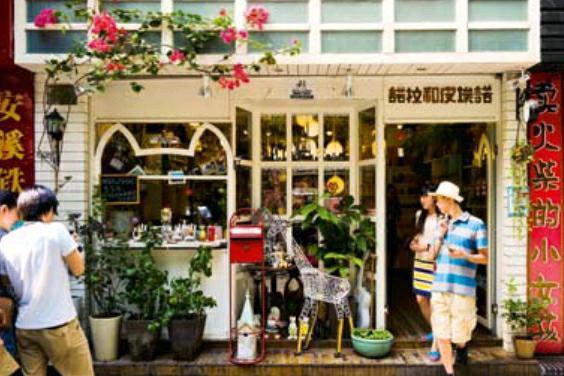Yesterday and Today:Garden on the Sea
2017-09-06byZhangXue
by+Zhang+Xue
Gulangyu, also known as Kulang- su, is a tiny island of less than two square kilometers that faces the mouth of the 600-meter-wide Lujiang River running through the port city of Xiamen on Chinas southeastern coast. On July 8, 2017, the Gulangyu historic international settlement was added to the World Heritage List as a cultural heritage site during the 41st session of the World Heritage Committee, making it Chinas 52nd listed property.
As the World Heritage Committee commented, Gulangyu Island witnessed the ups and downs of Chinas march into modernization and was surrounded by the early tides of globalization in the late Qing Dynasty (1644-1911). The island, a classic model of cultural exchange and mutual learning, was home to locals of Fujian Province, foreign expatriates and foreign-born Chinese communities. Over the years, it evolved into an international settlement known for cultural diversity and modern living.
Year round, tourists swarm to the island for its one-of-a-kind “petty bourgeoisie” flair. After marching the commercial streets, a stroll down an adjacent alley will reveal a different, peaceful side of Gulangyu. Away from the bustling crowds, you will see towering banyan trees, bougainvillea stretching from old yards, and trumpet vines on walls. Piano music reverberates through the air.
As far back as the 13th Century during the Song Dynasty (960-1279), fishermen from nearby areas began inhabiting the island. After the First Opium War in 1840, Western missionaries arrived at the island, and as Xiamen became a popular trading port, more and more churches were built. A modern international community gradually took shape as Chinese and Western residents lived together there and conducted profound cultural exchange on a daily basis.
More than 900 historic buildings of various architectural styles including traditional southern Fujian style, Western Renaissance style and Veranda colonial style still stand on the island. The buildings are testament to the evolution of local architecture coupled with a steady infusion of foreign cultures.
Residents of southern Fujian call their houses “cuo.” The Dafu Mansion and Fourrow Dacuo (traditional Chinese palatial residence with upturned eaves), built in the early 19th Century, are the oldest residential houses of southern Fujian style still standing. The Dafu Mansion was built by Huang Xuzhai, a Xiamen local, in the late Qing Dynasty. His son, Huang Kunshi, who was a senior official, built the Fourrow Dacuo to the right of the Dafu Mansion to house his seven children.


“Sea Paradise,” a group of five villas located at 38 Fujian Road, is a renowned combination of Chinese and Western architecture. The historic site, originally the only foreigners club in the concession area, is a palatial architectural complex that was fitted with an especially elaborate roof after Huang Xiulang, a Chinese expatriate based in the Philippines, purchased it in 1912.
Of the five old villas in Sea Paradise, three are open to public, one of which has been transformed into a café of Southeast Asian style and another is a performance center for local cultural shows.
Shuzhuang Garden, situated right on the seashore, is a crucial piece of any trip to Gulangyu Island. Against the backdrop of the vast sea, its traditional Chinese garden layout is unparalleled.
The cultural heritage of Gulangyu comprises 51 historic buildings, of which some have been abandoned, some renovated into villa hotels and others refitted as museums, cafés and book stores. Wander- ing tourists can get closer to the soul of Gulangyu through the legendary tales of the building owners.
Gulangyu is also called “piano island.”In the middle of the 19th Century, Western music gripped the island alongside the arrival of Christianity. The island was known for its music by the 1920s and 30s and began generating world-class musical talent. The long list of standouts from the island includes Zhou Shuan, Chinas first female conductor of vocal music, Lin Junqing, former president of an institute of vocal music studies in Shanghai, pianist Yin Chengzong and violinist Xu Feini. The“piano island” nickname is warranted: The islanders per capita piano ownership is the highest in the nation.
Big Names
Culturally diverse and inclusive Gulangyu Island is also known for the legends of contemporary celebrities.
Early in the 20th Century, ten-year-old Lin Yutang boarded a boat in a small town in Zhangzhou, Fujian Province, to head for the island. After three days on the waves, Lin enrolled at a church school there. He graduated from Yangyuan Elementary School and Xunyuan Middle School. At 24, Lin married Liao Cuifeng, a young woman from Xiamen, with a traditional Chinese ceremony in one of the islands Western churches, and then headed to study at Harvard University. Lin eventually became a cultural master of both Chinese and Western spheres.
Lin Qiaozhi, a Chinese pioneer in obstetrics and gynecology, was born in a teachers home on December 23, 1901. On the island, she enrolled in a childrens school and then Xiamen Womens Normal School. Her education continued at Beijing Union Medical College in 1921, and then she earned a doctoral degree at the State University of New York. Though unmarried throughout her life, Lin delivered more than 50,000 other peoples babies.
Ma Yuehan, Chinas earliest sports educator, spent his early days in Gulangyu at Fumin Elementary School. Ma then attended Saint Johns University in Shanghai, where he was a standout on the universitys sports team. After graduation, he began teaching at Tsinghua College, the predecessor of Tsinghua University. In 1936, he attended the 11th Olympic Games in Berlin as the chief coach of the Chinese delegation.